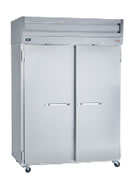Commercial Solid-Door Refrigerators and Freezers
Get Rebates,
Incentives & Services
Introduction
Commercial solid-door refrigerators and freezers are used for keeping food at safe storage temperatures within reach of the food operator. Unlike hot food holding cabinets, refrigerators and freezers are typically accessed many times during the day. These large appliances run 24 hours a day, 365 days a year.
Technology Options

The continuous operation of large commercial refrigerators and freezers equates to significant potential for energy conservation. Older refrigerators and freezers use considerably more power than newer ENERGY STAR models.
Refrigerators, although turned "on" all the time, cycle on and off at a rate that depends on several factors. These factors include room temperature, freezer temperature, how well the unit is insulated, how often the door is opened, cleanliness of the coil, whether it is defrosted regularly, and the condition of the door seal. The harder your refrigerator has to work to maintain a constant temperature, the more energy it will use.
ENERGY STAR Definition and Specification
Commercial Refrigerator: A cabinet designed for storing food or other perishable items at temperatures above 32 degrees Fahrenheit (F) but not greater than 40 degrees F.
Commercial Freezer: A cabinet designed for storing food or other perishable items at temperatures of 0 degrees F or below.
Commercial Refrigerator-Freezer: A cabinet with two or more compartments, at least one of which is designed for storing food or other perishable items at temperatures above 32 degrees F but not greater than 40 degrees F, and at least one of which is designed for storing food or other perishable items at temperatures of 0 degrees F or below.
Commercial Ice Cream Freezer: A cabinet designed for storing food or other perishable items at temperatures of –5 degrees F or below.
Commercial Refrigeration Cabinet: A refrigerator, freezer, or refrigerator-freezer for storing food products or other perishable items at specified temperatures and designed for use by commercial or institutional facilities.
Self-Contained Refrigeration Cabinet: A refrigerator or freezer which has the condensing unit built into the cabinet.
Product Life: A typical solid-door refrigerator or freezer is expected to last about 12 years.
Efficiency Benefits
Upgrading an older commercial refrigerator can save upwards of 480 kWh of electricity and over $60 per year in energy costs. Replacing an outdated solid-door commercial freezer can save more than 300 kWh and approximately $40 per year. A restaurant could save over $1,200 over the life of the units through these efficiency improvements.
Replacing an old refrigerator and freezer will also ensure consistent temperatures for food storage and increased food safety.
Solid-Door Refrigerator Example
| Cost-Effectiveness Example | |||
| Conventional Refrigerator | Energy Star Refrigerator | Savings | |
| Annual Energy Consumption | 2,102 kWh/year | 1,621 kWh/year | 481 kWh/year |
| Annual Energy Cost | $273.00 (CA) $210.00 (National) |
$211.00 (CA) $162.00 (National) |
$62.00 (CA) $48.00 (National) |
| Lifetime Energy Cost (12 year life) | $3,276.00 (CA) $2,520.00 (National) |
$2,532.00 (CA) $1,944.00 (National) |
$744.00 (CA) $576.00 (National) |
Source: ENERGY STAR Savings Calculator
Solid-Door Freezer Example
| Cost-Effectiveness Example | |||
| Conventional Freezer | Energy Star Freezer | Savings | |
| Annual Energy Consumption | 4,319 kWh/year | 4,008 kWh/year | 311 kWh/year |
| Annual Energy Cost | $561.00 (CA) $432.00 (National) |
$521.00 (CA) $401.00 (National) |
$40.00 (CA) $31.00 (National) |
| Lifetime Energy Cost (12 year life) | $6,732.00 (CA) $5,184.00 (National) |
$6,252.00 (CA) $4,812.00 (National) |
$480.00 (CA) $372.00 (National) |
Source: Food Service Technology Center Energy Savings Calculator
Manufacturers
A list of ENERGY STAR qualified solid-door refrigerator and freezer manufacturers can be found on ENERGY STAR’s web site.Purchasing Tips
|
||









